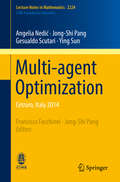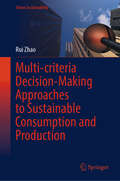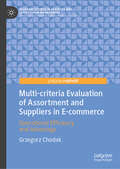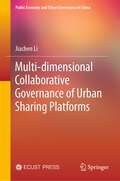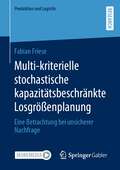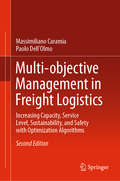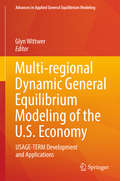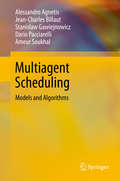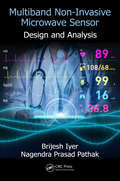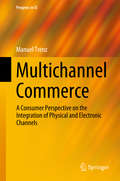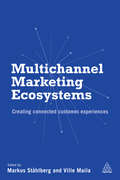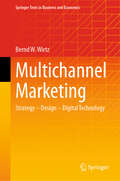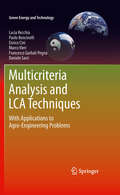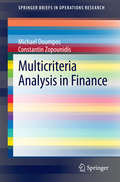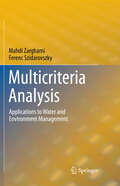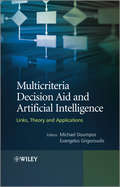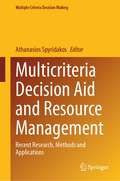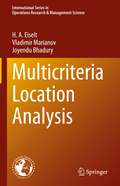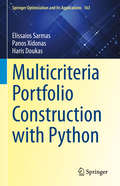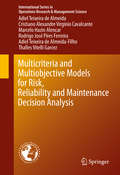- Table View
- List View
Multi-agent Optimization: Cetraro, Italy 2014 (Lecture Notes in Mathematics #2224)
by Angelia Nedić Jong-Shi Pang Gesualdo Scutari Ying Sun Francisco FacchineiThis book contains three well-written research tutorials that inform the graduate reader about the forefront of current research in multi-agent optimization. These tutorials cover topics that have not yet found their way in standard books and offer the reader the unique opportunity to be guided by major researchers in the respective fields. Multi-agent optimization, lying at the intersection of classical optimization, game theory, and variational inequality theory, is at the forefront of modern optimization and has recently undergone a dramatic development. It seems timely to provide an overview that describes in detail ongoing research and important trends. This book concentrates on Distributed Optimization over Networks; Differential Variational Inequalities; and Advanced Decomposition Algorithms for Multi-agent Systems. This book will appeal to both mathematicians and mathematically oriented engineers and will be the source of inspiration for PhD students and researchers.
Multi-criteria Decision-Making Approaches to Sustainable Consumption and Production (Urban Sustainability)
by Rui ZhaoThis book applies multi-criteria decision-making (MCDM) approaches to facilitate sustainable consumption and production. Sustainable consumption and production not only focuses on the economic prosperity but also pays great attention to environmental protection and social justice, in order to promote sustainable development. In such context, most ‘material’ can be deemed as ‘hazardous’ at any stage of their lifecycle, i.e., from extraction to final disposal, because of its quantity, concentration, or physical, chemical, or infectious characteristics, may cause, or pose a substantial or potential hazard to human health or the environment. Through the application of system theory, game theory, optimization theory, as well as various computational approaches, this book helps engineers/ policy makers to identify solutions or mitigation strategies to reduce environmental impact associated with consumption and production. It is essential reading for students, researchers, policy makers as well as those with a wider interest in environmental science and sustainable development.
Multi-criteria Evaluation of Assortment and Suppliers in E-commerce: Operational Efficiency and Advantage (Palgrave Studies in Logistics and Supply Chain Management)
by Grzegorz ChodakIn a rapidly changing e-commerce environment, effective supplier selection and inventory management are critical to maintaining competitive advantage and operational efficiency. This book introduces innovative multi-criteria decision-making models (MCDMs) and improved inventory classification systems tailored specifically for online retail environments. Combining theory and research-based case studies, the book highlights the importance of comprehensive criteria in supplier and assortment evaluation and the application of artificial intelligence in optimising decision models. It provides valuable insights and practical solutions for improving supply chain performance and inventory management in the e-commerce sector. It will be of great interest to scholars and students of logistics and e-commerce and supply chain management.
Multi-dimensional Approaches Towards New Technology: Insights on Innovation, Patents and Competition
by Indranath Gupta Ashish Bharadwaj Vishwas H. DevaiahThis open access edited book captures the complexities and conflicts arising at the interface of intellectual property rights (IPR) and competition law. To do so, it discusses four specific themes: (a) policies governing functioning of standard setting organizations (SSOs), transparency and incentivising future innovation; (b) issue of royalties for standard essential patents (SEPs) and related disputes; (c) due process principles, procedural fairness and best practices in competition law; and (d) coherence of patent policies and consonance with competition law to support innovation in new technologies. Many countries have formulated policies and re-oriented their economies to foster technological innovation as it is seen as a major source of economic growth. At the same time, there have been tensions between patent laws and competition laws, despite the fact that both are intended to enhance consumer welfare. In this regard, licensing of SEPs has been debated extensively, although in most instances, innovators and implementers successfully negotiate licensing of SEPs. However, there have been instances where disagreements on royalty base and royalty rates, terms of licensing, bundling of patents in licenses, pooling of licenses have arisen, and this has resulted in a surge of litigation in various jurisdictions and also drawn the attention of competition/anti-trust regulators. Further, a lingering lack of consensus among scholars, industry experts and regulators regarding solutions and techniques that are apposite in these matters across jurisdictions has added to the confusion. This book looks at the processes adopted by the competition/anti-trust regulators to apply the principles of due process and procedural fairness in investigating abuse of dominance cases against innovators.
Multi-dimensional Collaborative Governance of Urban Sharing Platforms (Public Economy and Urban Governance in China)
by Jiachen LiThis book gives a brief review of current development models and governance of urban sharing platforms, and looks into the economic efficiency of a novel market transaction model of sharing economy, which has been accelerated by high-density urban population and the Internet technology. With an aim to solve current problems featuring excessive competition, waste of resources, security risks, and unfair competition, this book delves into the two governance models in accommodation sharing platforms and bike and car sharing platforms and puts forward a multi-dimensional collaborative governance model that involves the participation of enterprises, the government, and the community. Under such a model, the platforms may utilize their own key technologies to implement supervision and solicit feedback; the government may resort to tax regulation and reallocating shared space to mitigate the negative externality effect and promote fair competition; and the community, as the basic unit of a city, may play its part through on-site participation and real-time feedback.
Multi-kriterielle stochastische kapazitätsbeschränkte Losgrößenplanung: Eine Betrachtung bei unsicherer Nachfrage (Produktion und Logistik)
by Fabian FrieseIn diesem Buch wird die Anwendung von Methoden der multi-kriteriellen Optimierung zur stochastischen kapazitätsbeschränkten Losgrößenplanung bei dynamischer und zufälliger Nachfrage diskutiert. Bei dieser Problemstellung ist die Minimierung der operativen Kosten nicht die einzige mögliche Zielsetzung. Die Minimierung der Verspätung bei der Bedienung der Kundennachfrage ist nicht weniger relevant. Außerdem sind Entscheidungspersonen an langfristiger Planbarkeit der Produktion sowie an Planungsstabilität interessiert. Zur simultanen Berücksichtigung dieser drei Zielsetzungen wird eine multi-kriterielle Formulierung des stochastischen kapazitätsbeschränkten Losgrößenplanungsproblems (MO-SCLSP) entwickelt. Die effiziente Ermittlung einer Vielzahl Pareto-optimaler Lösungen im Rahmen eines interaktiven Planungsansatzes erlaubt es Entscheidungspersonen, sich ökonomisch fundiert im Spannungsfeld der Priorisierung geringer operativer Kosten, hoher Lieferzuverlässigkeit und geringer Planungsnervosität zu positionieren.
Multi-objective Management in Freight Logistics: Increasing Capacity, Service Level, Sustainability, and Safety with Optimization Algorithms
by Massimiliano Caramia Paolo Dell’OlmoThe second edition of Multi-Objective Management in Freight Logistics builds upon the first, providing a detailed study of freight transportation systems, with a specific focus on multi-objective modelling. It offers decision-makers methods and tools for implementing multi-objective optimisation models in logistics. The second edition also includes brand-new chapters on green supply chain and hybrid fleet management problems.After presenting the general framework and multi-objective optimization, the book analyses green logistic focusing on two main aspects: green corridors and network design; next, it studies logistic issues in a maritime terminal and route planning in the context of hazardous material transportation. Finally, heterogeneous fleets distribution and coordination models are discussed.The book presents problems providing the mathematics, algorithms, implementations, and the related experiments for each problem. It offers a valuable resource for postgraduate students and researchers in transportation, logistics and operations, as well as practitioners working in service systems.
Multi-regional Dynamic General Equilibrium Modeling of the U.S. Economy: USAGE-TERM Development and Applications (Advances in Applied General Equilibrium Modeling)
by Glyn WittwerThis book details the preparation of USAGE-TERM, a computable general equilibrium model that provides regional economic detail in the USA. The model can represent either congressional district or state level economic activity. The latter may include a top-down representation of county activity. Interest in USAGE-TERM is growing among government departments. It is a practical tool, which may enhance analysis of productivity growth and innovation, adverse events such as drought or civil disruption and the dynamic economic impacts of major projects. Economic analysts and policy makers care about regions. Some regions suffer growing pains, as supporting infrastructure and services struggle to cope with population growth. Soaring house prices and rentals may lower affordability for many. Other regions suffer ongoing decline due to structural change. Regional economic fluctuations are often far more dramatic than national fluctuations.
Multi-variant User Interfaces in E-commerce: A Practical Approach to UI Personalization (Progress in IS)
by Adam WasilewskiThis book focuses on the personalisation of the user interface in e-commerce based on collected data on customer behaviour. While product recommendation systems are widely used for this purpose today, they do not allow for a comprehensive adaptation of the layout to different user groups. The proposed approach is based on the conclusion that since e-commerce customers are different, the user interface should also be different. To make this possible, several components need to be combined, which together allow the design of the online shop to be automatically or expertly adapted to the customer's choices and behaviour. It presents and discusses a framework that allows data to be collected, processed and used to optimise UI variants for generated customer segments. The proposed approach has been verified in practice and further developed on this basis, so that the reader is presented with a solution that is not riddled with 'baby age' problems, and the limitations and challenges identified are described and commented on in detail. Typical e-commerce systems currently have a single UI for all customers. The implementation of multi-variant UIs therefore represents an opportunity for companies to create a marketing advantage by addressing the personalisation trends in e-commerce.The book is intended for those responsible for developing e-commerce platform and user interfaces for web-based systems, as well as individuals interested in practical applications of machine learning in business.
Multiagent Scheduling
by Jean-Charles Billaut Alessandro Agnetis Stanisław Gawiejnowicz Dario Pacciarelli Ameur SoukhalScheduling theory has received a growing interest since its origins in the second half of the 20th century. Developed initially for the study of scheduling problems with a single objective, the theory has been recently extended to problems involving multiple criteria. However, this extension has still left a gap between the classical multi-criteria approaches and some real-life problems in which not all jobs contribute to the evaluation of each criterion. In this book, we close this gap by presenting and developing multi-agent scheduling models in which subsets of jobs sharing the same resources are evaluated by different criteria. Several scenarios are introduced, depending on the definition and the intersection structure of the job subsets. Complexity results, approximation schemes, heuristics and exact algorithms are discussed for single-machine and parallel-machine scheduling environments. Definitions and algorithms are illustrated with the help of examples and figures.
Multiasistencia: Redefining the Relationship with Its Service Professionals
by F. Asis Martinez-Jerez Katherine Miller Maria Garcia PerezMultiasistencia, a major Spanish BPO of insurance repairs, is changing the relational contract with its service professionals from a referral model to a guaranteed workload one.
Multiband Non-Invasive Microwave Sensor: Design and Analysis
by Brijesh Iyer Nagendra Prasad PathakThis monograph focuses on the design, implementation and characterization of a concurrent dual band RF sensor for non-invasive detection of human vital signs. Exclusive title on multiband short range sensors and their biomedical applications, offers detailed analysis of subsystems based on fabricated and measured prototypes and verifies and discusses the system in the real-time environment. <P><P> Discusses the practical difficulties of the design process and offers case studies based on the design.
Multichannel Commerce
by Manuel TrenzThis book takes an in-depth look at consumer behavior in the context of multichannel commerce and explores how the convergence of physical and electronic channels influences consumer decision-making in a multichannel environment. In this regard, it goes far beyond explaining choices between online and offline sales channels, instead providing insights into how the interplay between different channel types is valued by different consumer types and for different products. The book extends previous conceptualizations of multichannel commerce to reflect and incorporate recent technological advances. The results provide valuable guidelines on how, why and when multichannel integration services can be exploited by classical retailers, helping them to compete with their purely online competitors on the internet.
Multichannel Marketing Ecosystems
by Ville Maila Markus StåhlbergWith dramatic changes in consumer behaviour - from online shopping to the influence of social media - marketers are finding it harder than ever to coordinate, prioritize and integrate the latest interactive channels into their overall brand-building strategy. Despite hard evidence showing the importance of digital marketing, the emphasis often remains on traditional media, with the most common social media channels being used without centralized coordination or integration with a wider marketing and branding campaign.Multi-Channel Marketing Ecosystems examines a fundamental game changer for the entire marketing industry - the seismic shift from a single TV-centric path to a multi-channel interactive ecosystem which puts digital technology at the heart of every campaign. With separate chapters on the remaking of marketing, the rise of the digital brand, conversion optimization, m-commerce, searchability in a multi-channel world and predictive marketing, Multi-Channel Marketing Ecosystems shows how marketers and brand managers can react positively to changes in consumer behaviour, building customer responses and loyalty via the full spectrum of digital media.
Multichannel Marketing: Strategy – Design – Digital Technology (Springer Texts in Business and Economics)
by Bernd W. WirtzIncreasing customer demands and innovations in digital sales require targeted management and flexible organisation of multiple sales channels. Multi-channel marketing can be used to achieve outstanding competitive advantages. This book provides a comprehensive and systematic overview of the fundamentals and management of multi-channel marketing. The book understands multi-channel marketing as an integrative marketing system with special consideration of digital technologies. “Multi-Channel-Marketing is with increasing frequency a key success factor for companies in competition for customers. Bernd Wirtz’ textbook provides a clearly patterned, incorporated and theoretically funded overview for this purpose. The author excellently succeeded in illustrating in a descriptive way the considerable complexity and breadth of applicability and contemporaneously establishing a high practical relevance.” Dr. Rainer Hillebrand, Member of the Supervisory Board Otto Group (2019-), Member of the Executive Board of the Otto Group for Strategy, E-Commerce, Business Intelligence (1999-2019) “Wirtz examines the whole path down from theoretical basic knowledge of Multi-Channel-Marketing right up to the practical realization. This book is a needed approach which is at the same time a reference book for specific issues. The Wirtz’ is essential for everyone who is concerned with this highly topical subject in his studies or in practice already.” Dr. Arno Mahlert, Chief Executive Officer Tchibo Holding AG (2004-2009), Member of the Board of Directors Peek&Cloppenburg KG and maxingvest AG
Multicriteria Analysis and LCA Techniques
by Francesco Garbati Pegna Paolo Boncinelli Marco Vieri Daniele Sarri Enrico Cini Lucia RecchiaMulticriteria Analysis and LCA Techniques introduces the reader to the basic principles of multicriteria analysis (MCA) and life cycle assessment (LCA) techniques. The use of these tools is rapidly becoming essential in any feasibility study for comparing different solutions, selecting the most suitable ones, and for analyzing the interface of economy and environment. The main feature of Multicriteria Analysis and LCA Techniques is the application of a new approach to the analysis of energy balance and environmental impact of agro-industrial production chains. It gives detailed descriptions of a number of food and non-food agro-industrial applications of MCA and LCA, thereby providing the reader with practical examples of the implementation of these tools in the field of agro-industry. Multicriteria Analysis and LCA Techniques represents a subsidiary reference book for both undergraduate and graduate students, and can also be used for basic or applied academic research.
Multicriteria Analysis in Agriculture: Current Trends and Recent Applications (Multiple Criteria Decision Making)
by Nikolaos Matsatsinis Julio Berbel Thomas Bournaris Basil Manos Davide ViaggiThis book outlines the latest trends in the use of multicriteria analysis in agriculture by highlighting recent applications for modeling agricultural decision-making. It introduces specific case studies using multicriteria analysis as a method for selecting multiattribute discrete alternatives or solving multiobjective planning problems. The book is intended for a broad readership, including agricultural and environmental economists, engineers and all scientists whose work involves the management of agricultural resources and decision-making in agriculture. The methods and applications presented in this book cover decision-making processes in agricultural and environmental contexts. The methodologies described consider multiple criteria simultaneously in a wide range of complex decision-making contexts by taking into account multiple, conflicting criteria. Given the wide range of case studies covered, the book offers a comprehensive guide to decision-making in the agricultural context and beyond.
Multicriteria Analysis in Finance
by Constantin Zopounidis Michael DoumposThis book provides a concise introduction into the fundamentals and applied techniques of multiple criteria decision making in the finance sector Based on an analysis of the nature of financial decisions and the general methods of financial modelling, risk management and financial engineering, the book introduces into portfolio management, banking management and credit scoring. Finally the book presents an overview of further applications of multi criteria analysis in finance and gives an outlook on future perspectives for the application of MCDA in finance.
Multicriteria Analysis: Applications to Water and Environment Management
by Ferenc Szidarovszky Mahdi ZarghamiMulticriteria analysis is one of the most important fields of decision science. This book gives an outline of the formulation of an appropriate model and presents a comprehensive summary of the most popular methods for solving multicriteria decision problems. In addition to the classical approach the book introduces fuzzy and stochastic methodology, models with uncertainty, social choice and conflict resolution. All methods are illustrated with easy to follow simple examples. At the end of each chapter detailed case studies are given in water and environment management including inter-basin water transfer, urban water management, water allocation, groundwater quality management, forest treatment, ranking water resources projects, reservoir planning, water distribution network design and long-term watershed management. The new methodology and the wide variety of case studies are not easily accessible elsewhere.
Multicriteria Decision Aid and Artificial Intelligence: Links, Theory and Applications
by Michael Doumpos Evangelos GrigoroudisPresents recent advances in both models and systems for intelligent decision making. Organisations often face complex decisions requiring the assessment of large amounts of data. In recent years Multicriteria Decision Aid (MCDA) and Artificial Intelligence (AI) techniques have been applied with considerable success to support decision making in a wide range of complex real-world problems. The integration of MCDA and AI provides new capabilities relating to the structuring of complex decision problems in static and distributed environments. These include the handling of massive data sets, the modelling of ill-structured information, the construction of advanced decision models, and the development of efficient computational optimization algorithms for problem solving. This book covers a rich set of topics, including intelligent decision support technologies, data mining models for decision making, evidential reasoning, evolutionary multiobjective optimization, fuzzy modelling, as well as applications in management and engineering. Multicriteria Decision Aid and Artificial Intelligence: Covers all of the recent advances in intelligent decision making. Includes a presentation of hybrid models and algorithms for preference modelling and optimisation problems. Provides illustrations of new intelligent technologies and architectures for decision making in static and distributed environments. Explores the general topics on preference modelling and learning, along with the coverage of the main techniques and methodologies and applications. Is written by experts in the field. This book provides an excellent reference tool for the increasing number of researchers and practitioners interested in the integration of MCDA and AI for the development of effective hybrid decision support methodologies and systems. Academics and post-graduate students in the fields of operational research, artificial intelligence and management science or decision analysis will also find this book beneficial.
Multicriteria Decision Aid and Resource Management: Recent Research, Methods and Applications (Multiple Criteria Decision Making)
by Athanasios SpyridakosThis book is focused on the application of methodological approaches and systems of multiple criteria decision analysis (MCDA) in the field of resource management. Resource management constitutes a major challenge of modern times. The book comprehensively examines cases of human resources, material resources and natural resources in particular. It focuses on the efficient utilization of these resources to achieve sustainability of economic, environmental and social aspects. Also, the book presents methodological tools which aim to support the decision making at operational, executive and strategic levels.The book presents recent results of scientific research in the field of MCDA and its applications to resource management. It investigates the resource management challenges and introduces innovative methodological approaches and systems for addressing these resources management issues.
Multicriteria Decision Aiding Interventions: Applications for Analysts (Multiple Criteria Decision Making)
by Maria Franca Norese María A. De Vicente y Oliva Irène Abi-ZeidThis book introduces readers to multicriteria decision aiding (MCDA) interventions used in complex situations. In each chapter, expert analysts propose a piece of the puzzle, while the final, complete puzzle offers an interesting reflection of the main challenges and difficulties associated with decision aiding interventions, as well as the different tools adopted in response. Particular attention is given to the approaches used to identify and overcome specific difficulties.Designed for analysts familiar with several multicriteria methods but seeking detailed information and experience, this book helps to elaborate and validate MC models in real-life decision aiding interventions. In addition, it helps novice analysts appreciate the difficulty of decision aiding and use the available methods to reduce or control them with the help of socio-technical approaches.
Multicriteria Location Analysis (International Series in Operations Research & Management Science #338)
by Vladimir Marianov H. A. Eiselt Joyendu BhaduryThis book applies Multicriteria Decision Making (MCDM) tools and techniques to problems in location analysis. It begins with a generic model for MCDM and subsequently develops specific versions of the technique for particular location problems. Throughout the book, MCDM is understood to encompass all tools and techniques that choose or rank existing or feasible solutions, including discrete multi-attribute decision making (MADM) problems, which typically include an attribute table that specifies the consequences of each decision with regard to the given criteria, as well as multi-objective linear problems (MOLPs), which incorporate all objectives in a single optimization problem. The book is organized as follows: the first four chapters introduce readers to the basic tools and techniques used in single-objective optimization, multicriteria decision making, location analysis, and other tools, such as statistical regression and geographical information systems. This is followed by ten chapters on model applications, each of which introduces readers to a specific location problem and applies one technique to solve it. The book is then wrapped up in a closing chapter that looks at the location process from a practitioner’s point of view. This book is intended as a textbook for upper-undergraduate and master-level courses on location analysis. It will also benefit decision-makers who actually need to locate facilities.
Multicriteria Portfolio Construction with Python (Springer Optimization and Its Applications #163)
by Panos Xidonas Haris Doukas Elissaios SarmasThis book covers topics in portfolio management and multicriteria decision analysis (MCDA), presenting a transparent and unified methodology for the portfolio construction process. The most important feature of the book includes the proposed methodological framework that integrates two individual subsystems, the portfolio selection subsystem and the portfolio optimization subsystem. An additional highlight of the book includes the detailed, step-by-step implementation of the proposed multicriteria algorithms in Python. The implementation is presented in detail; each step is elaborately described, from the input of the data to the extraction of the results. Algorithms are organized into small cells of code, accompanied by targeted remarks and comments, in order to help the reader to fully understand their mechanics. Readers are provided with a link to access the source code through GitHub.This Work may also be considered as a reference which presents the state-of-art research on portfolio construction with multiple and complex investment objectives and constraints. The book consists of eight chapters. A brief introduction is provided in Chapter 1. The fundamental issues of modern portfolio theory are discussed in Chapter 2. In Chapter 3, the various multicriteria decision aid methods, either discrete or continuous, are concisely described. In Chapter 4, a comprehensive review of the published literature in the field of multicriteria portfolio management is considered. In Chapter 5, an integrated and original multicriteria portfolio construction methodology is developed. Chapter 6 presents the web-based information system, in which the suggested methodological framework has been implemented. In Chapter 7, the experimental application of the proposed methodology is discussed and in Chapter 8, the authors provide overall conclusions.The readership of the book aims to be a diverse group, including fund managers, risk managers, investment advisors, bankers, private investors, analytics scientists, operations researchers scientists, and computer engineers, to name just several. Portions of the book may be used as instructional for either advanced undergraduate or post-graduate courses in investment analysis, portfolio engineering, decision science, computer science, or financial engineering.
Multicriteria and Multiobjective Models for Risk, Reliability and Maintenance Decision Analysis
by Adiel Teixeira de Almeida Cristiano Alexandre Virgínio Cavalcante Marcelo Hazin Alencar Rodrigo José Pires Ferreira Adiel Teixeira de Almeida-Filho Thalles Vitelli GarcezThis book integrates multiple criteria concepts and methods for problems within the Risk, Reliability and Maintenance (RRM) context. The concepts and foundations related to RRM are considered for this integration with multicriteria approaches. In the book, a general framework for building decision models is presented and this is illustrated in various chapters by discussing many different decision models related to the RRM context. The scope of the book is related to ways of how to integrate Applied Probability and Decision Making. In Applied Probability, this mainly includes: decision analysis and reliability theory, amongst other topics closely related to risk analysis and maintenance. In Decision Making, it includes a broad range of topics in MCDM (Multi-Criteria Decision Making) and MCDA (Multi-Criteria Decision Aiding; also known as Multi-Criteria Decision Analysis). In addition to decision analysis, some of the topics related to Mathematical Programming area are briefly considered, such as multiobjective optimization, since methods related to these topics have been applied to the context of RRM. The book addresses an innovative treatment for the decision making in RRM, thereby improving the integration of fundamental concepts from the areas of both RRM and decision making. This is accomplished by presenting an overview of the literature on decision making in RRM. Some pitfalls of decision models when applying them to RRM in practice are discussed and guidance on overcoming these drawbacks is offered. The procedure enables multicriteria models to be built for the RRM context, including guidance on choosing an appropriate multicriteria method for a particular problem faced in the RRM context. The book also includes many research advances in these topics. Most of the multicriteria decision models that are described are specific applications that have been influenced by this research and the advances in this field. Multicriteria and Multiobjective Models for Risk, Reliability and Maintenance Decision Analysis is implicitly structured in three parts, with 12 chapters. The first part deals with MCDM/A concepts methods and decision processes. The second part presents the main concepts and foundations of RRM. Finally the third part deals with specific decision problems in the RRM context approached with MCDM/A models.
